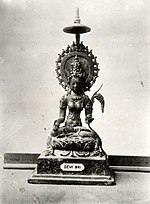This article needs additional citations for verification. (April 2024) |
| Wayang beber | |
|---|---|
 | |
| Types | Traditional puppet theatre |
| Ancestor arts | Javanese people |
| Originating culture | Indonesia |
| Originating era | Hindu - Buddhist civilisations |
| Wayang Puppet Theatre | |
|---|---|
 The Wayang Kulit performance by the Indonesian famous "dalang" (puppet master) Manteb Soedharsono, with the story "Gathutkaca Winisuda", in Bentara Budaya Jakarta, Indonesia, on 31 July 2010 | |
| Country | Indonesia |
| Criteria | Performing arts, Traditional craftsmanship |
| Reference | 063 |
| Region | Asia and the Pacific |
| Inscription history | |
| Inscription | 2008 (3rd session) |
| List | Representative List |
 Wayang Kulit (the leather shadow puppet), Wayang Klithik (the flat wooden puppet), Wayang Golek (the three-dimensional wooden puppet) | |
| This article is a part of the series on |
| Indonesian mythology and folklore |
|---|
 |
|
|
Wayang beber (Javanese: ꦮꦪꦁꦧꦺꦧꦺꦂ) is an Indonesian wayang performance art whose presentation is manifested in a stretch sheets of paper or cloth with pictures in the stylized wayang accompanied by a narration by a dalang.[1] Wayang beber performances emerged and developed in Java in pre-Islamic times, but continued into the Islamic kingdoms (such as the Sultanate of Mataram). The stories shown are taken from the Mahabharata and the Ramayana. After Islam became the main religion in Java, more Panji stories were shown.[2] Wayang beber bears a strong resemblance to narrative in the form of pictorial ballads common at annual fairs in medieval and early modern Europe. They too suffered the same fate—nearly extinct, although there are still groups of artists who support wayang beber in places like Surakarta (Solo) in Central Java.
- ^ "Kisah Wayang Beber, Wayang Tertua di Indonesia", Indonesia.go.id
- ^ "The metamorphosis of wayang beber", Jakarta Post